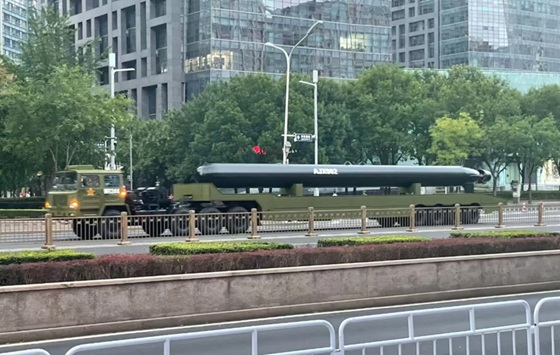In a striking display of military ambition, China appears poised to showcase a formidable new unmanned underwater vehicle (UUV) during rehearsals for an upcoming military parade, as evidenced by photographs circulating on social media and reported by defense outlets. The images, captured in late July 2025, depict a massive, black, torpedo-shaped drone being transported on a flatbed truck, sparking intense speculation about its capabilities, purpose, and technological underpinnings. While Chinese authorities have yet to officially name or describe the system, its appearance has drawn inevitable comparisons to Russia’s Poseidon, a nuclear-powered, nuclear-armed underwater drone unveiled by President Vladimir Putin in 2019 as part of Russia’s arsenal of “superweapons.”
The UUV’s sleek, elongated design, estimated to be over 10 meters in length based on the proportions seen in the photographs, suggests a platform engineered for stealth, endurance, and potentially devastating payloads. Observers have noted its resemblance to Poseidon, formally known as Status-6, a strategic weapon designed to travel thousands of miles underwater to deliver nuclear warheads against coastal cities, naval bases, or carrier strike groups. However, while the visual similarities are undeniable, Chinese sources have hinted that their system may diverge significantly in both technology and mission.
According to a 2024 report by the South China Morning Post (SCMP), China has been actively pursuing nuclear-powered undersea systems, with research focusing on a novel propulsion concept. The SCMP cited Chinese researchers who described a UUV powered by a disposable nuclear reactor, capable of propelling the drone at speeds exceeding 30 knots (approximately 35 miles per hour) for up to 200 hours. This reactor, once depleted, would detach and sink to the ocean floor, allowing the vehicle to switch to battery power for the final phase of its mission, potentially executing a conventional or nuclear strike. This innovative approach to propulsion could enable unprecedented range and endurance, making the UUV a versatile tool for both tactical and strategic operations.
Despite the SCMP’s insights, critical details about the Chinese UUV remain shrouded in secrecy. The photographs from the parade rehearsals confirm the system’s physical existence but offer no clarity on its propulsion system, operational range, payload capacity, or intended role. Analysts are divided on whether the drone is designed for strategic deterrence, like Poseidon, or for more localized missions, such as targeting naval assets in the South China Sea or disrupting undersea infrastructure like communication cables. The possibility of nuclear armament remains unconfirmed, though the system’s size and reported nuclear propulsion suggest it could carry significant payloads, conventional or otherwise.
The comparison to Russia’s Poseidon has fueled intense debate among defense analysts. Poseidon, first revealed in a televised address by Putin, is a doomsday weapon designed to bypass traditional missile defenses by traveling underwater at extreme depths and distances. With a reported range of 10,000 kilometers and the ability to carry a multi-megaton nuclear warhead, Poseidon is intended to ensure Russia’s retaliatory capability in a nuclear conflict. Its development has been a cornerstone of Russia’s strategic posturing, with deployments reportedly underway in the Arctic and Pacific regions by 2025.
In contrast, Chinese researchers have sought to distance their project from Poseidon. Guo Jian, a nuclear scientist at the China Institute of Atomic Energy, published an article in the Journal of Unmanned Underwater Systems in 2024, emphasizing “substantial differences” between China’s UUV and its Russian counterpart. While Guo did not disclose specifics, he suggested that China’s design prioritizes flexibility and technological innovation over sheer destructive power. For instance, the disposable reactor concept, if realized, would mark a significant departure from Poseidon’s continuous nuclear propulsion, potentially reducing costs and environmental risks while maintaining operational effectiveness.
The unveiling of this UUV comes at a time of heightened geopolitical tensions, particularly in the Indo-Pacific region, where China’s naval ambitions have drawn scrutiny from the United States, Japan, and other regional powers. The South China Sea, a contested hotspot, could serve as a primary operational theater for such a system, allowing China to project power, deter adversaries, or conduct covert operations. Alternatively, the drone could be part of China’s broader strategy to counter U.S. naval dominance, particularly in response to carrier strike groups and submarine patrols.
The parade rehearsals, believed to be in preparation for a major national event, underscore China’s intent to showcase its technological prowess and military modernization. The UUV’s public debut, even in a limited capacity, signals Beijing’s confidence in its undersea capabilities and its willingness to compete with global powers in the domain of autonomous naval warfare. However, the lack of official commentary leaves room for speculation about the system’s readiness, with some analysts suggesting it may still be in the prototype or testing phase.
As global attention turns to this enigmatic new weapon, questions abound: Is China’s UUV a direct answer to Poseidon, or does it represent a distinct vision for undersea warfare? Could its deployment reshape naval strategies in the Indo-Pacific? For now, the answers remain as elusive as the depths the drone is designed to navigate.
Discover more from Defence Talks | Defense News Hub, Military Updates, Security Insights
Subscribe to get the latest posts sent to your email.





